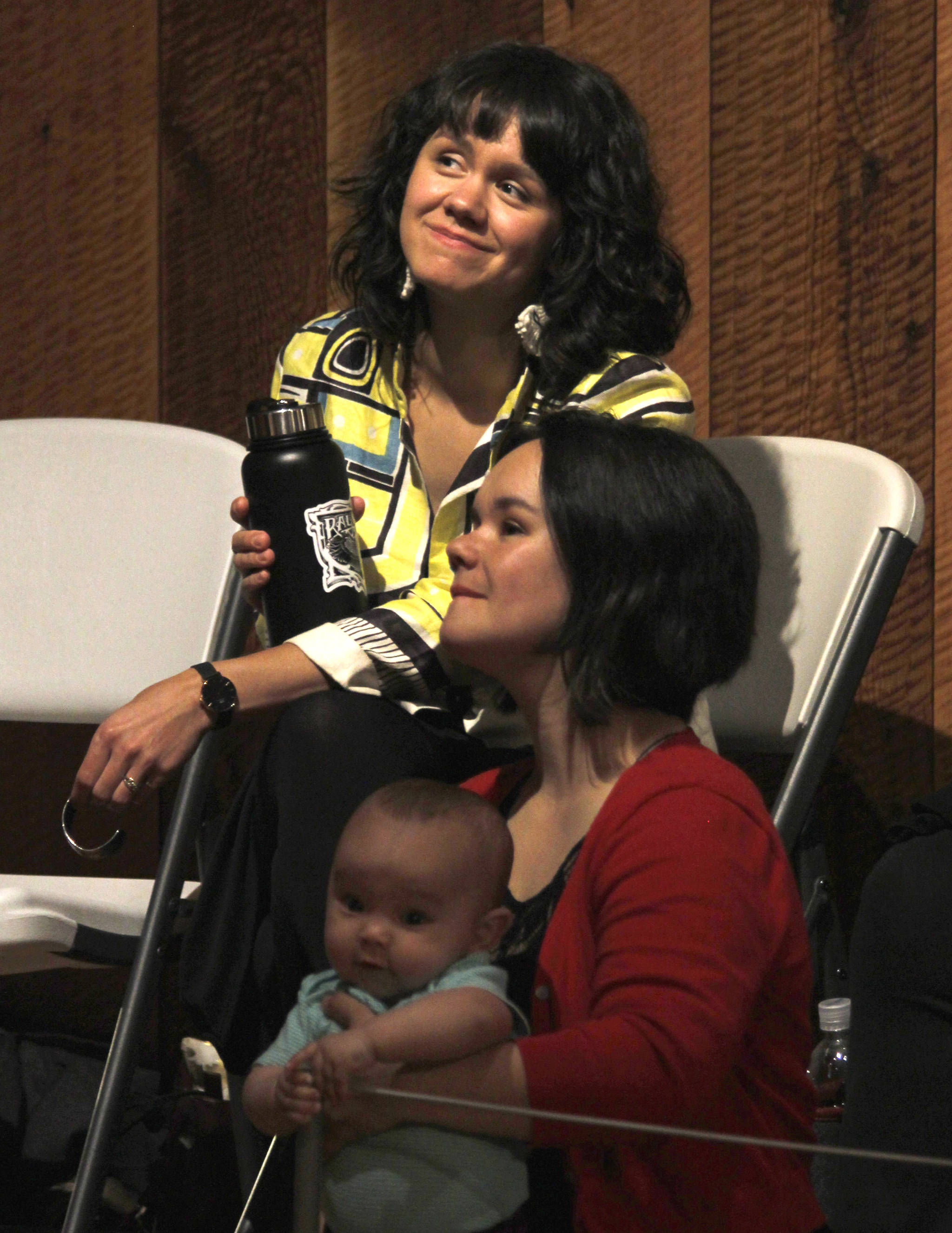Long before they started weaving, Lily Hope and Ursala Hudson were woven into an ancient artform without knowing it.
Their mother, the late weaver Clarissa Rizal, put a meaningful signature on each of her Chilkat and Ravenstail robes, garments historically worn as status symbols in Tlingit, Haida and Tsimshian cultures that were also given as gifts ceremonially. Rizal wrapped three bands of string around part of the fringe in one corner, with each band of string carrying a different meaning.
The top band, dyed yellow, represents the number of robes she had made to that point. For example, her 11th robe had 11 yellow threads in this top band. The next group of thread, colored white, represented how many grandchildren she had at the time.
The final layer of thread, also colored yellow, represented how many children she had. This layer always had three yellow threads: one for Lily, one for Ursala and one for their older brother Kahlil Hudson.
“She included us in everything she was doing,” Hope said, “and we didn’t even realize what she was leading us into until she was gone and we were left standing, holding these left strands.”
Now, Hope said, they’re trying to pick up those strands and continue weaving — and teaching others about weaving — as their mother did.
Prior to her death due to cancer at the age of 60 in December 2016, Rizal led a presentation at the biennial Celebration event in Juneau about Chilkat and Ravenstail weaving. This Wednesday, Hope and Hudson led that same presentation together.
The process of weaving a Chilkat or Ravenstail robe can last months or years, as weavers have to create the thread from mountain goat wool or other sources before even starting to weave the robes on large looms. Ravenstail weaving, as presenters explained Wednesday, was the original form of weaving these robes, involving twining and surface braiding, and it evolved into Chilkat weaving. While Ravenstail weaving focuses more on geometric patterns, Chilkat weaving often involves animal forms.
Rizal’s name was brought up repeatedly, as former students and colleagues of hers spoke glowingly and her daughters told anecdotes of her life. Hudson, 30, said it was difficult at times to listen to presenters and to think about her mother on this same stage just two years ago.
“She had a vibrancy and a spunk that kept things entertaining,” Hudson said. “I just felt sad for everyone who knew her and who didn’t know her who was feeling that void.”
Fellow weaver and presenter Shgen George began her talk by saying it was hard not to tear up as she watched the sisters lead the presentation because “the last time we did this it was with Clarissa.”
Along with the sadness that comes with a departure, there was also the exuberance of young weavers and new robes and projects. Fewer and fewer people know how to make Chilkat or Ravenstail robes, and Hope mentioned that even fewer people — maybe only a few dozen, she estimated — have both the ability and the time to create these complex works.
The main theme of the presentation, entitled “Listening to our Teachers: Bringing History to the Present in Chilkat and Ravenstail Weaving,” was that it’s possible and valuable to build on the traditional style of weaving with new techniques and concepts.
Weavers answered questions and carried on conversations about dying techniques, color usage and new styles. Hope particularly praised the work of weaver Kay Parker, whom Hope called “a model for bringing the ancient into the contemporary.”
Hope, 38, said during the presentation that she began weaving when she was 15. She’s continued weaving and recently earned a Native Arts and Cultures Foundation mentor apprentice grant to work with a younger weaver on a project.
Hudson, on the other hand, only started weaving just a few months before her mother’s death. Hudson decided to try her hand at it by getting involved in Rizal’s “Weavers Across the Water” project that brought more than 40 weavers together to make a robe.
Hudson said she was shocked at how easily it came to her. She had watched her mother weave for so many years that her hands and fingers already knew what to do.
“I didn’t have to think,” Hudson said. “It was like I had her hands.”
That learning process appears to already be at work with their children as well, both Hope and Hudson said. Hudson’s 8-year-old daughter tried her hand at weaving just last week, and is already “hooked,” Hudson said. Hope said her 10-year-old daughter is getting started as well.
For most of Wednesday’s presentation, Hope carried around her 8-month-old daughter, who was conceived shortly after Rizal’s death. The daughter’s name is Anastasia Clarissa Hope. Lily said it felt right to name her daughter after her grandmother, but that it was a little too soon to give her Clarissa as a first name.
Like Hudson described from experience, Anastasia is already feeling comfortable and curious when she’s around the loom. Hope bounced Anastasia on her hip as she said the baby’s hands are already getting familiar with the threads.
“This one comes to work with me every day,” Hope said, “so she’s up in the fibers and playing with it.”
• Contact reporter Alex McCarthy at 523-2271 or amccarthy@juneauempire.com. Follow him on Twitter at @akmccarthy.

